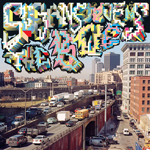|
|
 |
Dusted Reviews
Artist: Sufjan Stevens Album: The BQE Label: Asthmatic Kitty Review date: Oct. 19, 2009 |

|
|
|
 |
Originally commissioned for and performed at the Brooklyn Academy of Music in Fall 2007, Sufjan Stevens’ 40-minute instrumental composition The BQE is finally making its debut on CD a long two years later. While only the track titles serve to suggest the subject matter, the piece purports to be about the Brooklyn-Queens Expressway. As if to make up for the wait, the album comes packaged with plenty of extras, including a DVD of the film footage projected during the BAM performance and an elaborate graphic novel-like booklet. It is, however, the sharp incongruity between content and packaging – this case, the gap between a surprisingly concise (for the usually long-winded Stevens) and mature composition and a garish and unnecessarily inflated presentation (much like the one that accompanied the work at BAM) – that reveals the most about Stevens as an artist.
Stevens’ past albums, and 2005’s Illinois above all, have often seemed like the work of two artists who don’t work terribly well together. On one hand, they are marked with a gentle humaneness and earnestness, both in the music and the short-story sketch lyrics, while on the other they constantly strain toward cleverness, exhibiting an off-putting degree of self-satisfaction, and a disturbing sense of unnecessary self-irony. The same dynamic is at work on The BQE, but its elements have been modified: the biggest shift, of course, is that there are no lyrics. This, on one hand, deprives Stevens of the opportunity to counterbalance his elaborate arrangements with his humble vocals, but on the other, prevents him from sinking into the morass of cultural references that made Illinois and The Avalanche a little too clever for their own good. A move away from words seems to befit Stevens at this point: despite its thematic nature, The BQE is more about music (both that of Stevens and that of the American composers he draws upon) than the plethora of people, places or things that populated his past few efforts.
With words gone, The BQE reproduces Stevens’ internal war between unabashed sincerity and the self-irony that second guesses it on a purely musical level; the latter, however, fades largely into the background, hovering around the margins rather than threatening to define the mood of the piece as a whole. All of the elements we’ve come to expect from his past work are in evidence here: the Phillip Glass-inspired taste for the layered repeating patterns (“Linear Tableau with Intersecting Surprise”), the Copland-esque Americana (“Introductory Fanfare”), the nervously playful winds, and the regal trumpet solos. Newly prominent is a jazzier element, one which seems to result from an association between Gershwin’s orchestral works and the urban environment Stevens thematizes here: “Self-Organizing Emergent Patterns” at moments more or less cites “Rhapsody in Blue” in order to evoke the frenetic pace of modern city life. Despite the dead-seriousness of most of the music here, Stevens can’t resist a little joke: it’s the “surprise” array of analog synths and 8-bit twittering that follows the aforementioned “Linear Tableau,” entitled “Traffic Shock.” While it does indeed come as a surprise, and potentially a quite jarring one, it’s not enough to kill the mood.
The only thing that threatens to undermine the musical accomplishments of The BQE is the sense of irony that underlies its choice of subject matter: if the BQE is, as Stevens has claimed, “one of the world’s ugliest expressways,” one would expect the piece to be either a musical journey into urban squalor and decrepitude or an ironized inflation of a less-than-monumental landmark. Neither of these paths seems to have been taken in the music, which acts as a kind of overview and recapitulation of 20th-century American music’s representations of the urban without a clear position, either laudatory or denigrating, in respect to its subject matter. It works best on a purely musical level: as with most of Stevens’ albums, The BQE is best listened to in complete ignorance of the track titles, packaging, or even professed subject matter. The music speaks best when it speaks for itself.
By Michael Cramer
|







